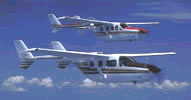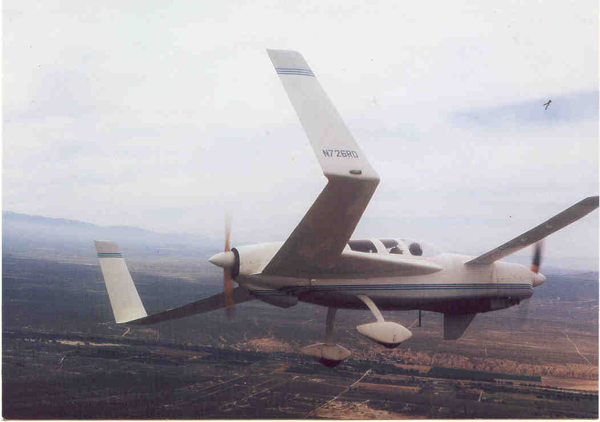
|
The Rutan Defiant Contributed by David Orr.
THE RUTAN DEFIANT Burt Rutan applied himself to the problems of building a canard-controlled, centerline thrust twin, and the result was a Star Wars design know as the Defiant. The cost of certification, especially on such an unconventional design, apparently scared off all the prospective investors, and the prototype became little more than Burt’s personal transportation airplane. To call this a shame is an understatement, as the defiant was a definite step ahead in safety, performance and efficiency. Unfortunately, it was perhaps a little too far ahead. Like the canard designs that preceded it, the Defiant reflects an overriding concern for the health and safety of its passengers. Rutan pulled out all the stops when he built the Defiant, designing an airplane that would effectively avoid all the traps of twin-engine airplanes flown on one mill. To better understand exactly what Rutan and Keller had achieved in the Defiant, I went to Mojave and flew the prototype with RAF pilot Mike Melvill. Once you walk up to the Defiant on the ramp, you know this is a different breed of airplane. Like all recent Rutan designs, the Defiant (technically designated the RAF-40 – Rutan’s fortieth design) utilizes a canard on the nose for pitch control, winglets and a retractable nosegear with fixed, slickly faired mains. Typically, the Defiant realizes economies of design not possible on normal twins. The RAF-40’s airframe has a wetted area only 56 percent that of normal twins, and the winglets offer 30 percent less induced drag by increasing the effective span. Unlike even his single-engine designs, however, Rutan’s Defiant mounts a pair of 160-hp O-320 Lycoming engines inline to eliminate any possibility of asymmetric thrust, ala Cessna’s now out-of-production 337 Skymaster. Pilots who have flown the Skymaster will tell you that it was, like the Defiant, a docile twin. Climb aboard over the cabin walls and you find that the cabin configuration is comfortable for the pilot and all three passengers. The panel is spacious and wide, easily large enough to accept almost any avionics you might install. Engine start is conventional carburetted Lycoming. Power controls are similar to those of twins with engines on the wings. The left throttle controls the forward engine and has a small horn pointing forward mounted to its left side, while the right manages power on the rear, and accordingly has a horn pointing aft. On Rutan’s airplane, you can, for all practical purposes, fly the airplane as if it were a single and move both throttles together, whether on or both engines are running. That, in fact, is one of the great joys of the Defiant. It’s an amazingly forgiving airplane in single-engine mode. It wouldn’t be a particularly bright idea to initiate a single-engine takeoff, however, especially at Mojave’s 3000-foot pressure altitude. (Cessna found this to be a particularly vexing problem on the Skymaster, as some pilots would blindly attempt to depart on the front engine alone after the rear engine had idled out during taxi or runup. As a result, the company developed the procedure of advancing the rear throttle first on takeoff, then the front throttle.) Off the ground and stabilized at 100 knots with the nose gear retracted, the Defiant climbs as if something big were chasing it. With just Melvill and me aboard, I saw initial VSI readings of nearly 2000 fpm. The spec for full gross (of 2900 pounds) at sea level is 1600, and I’d guess the Defiant could easily achieve such a number. Better still, the Defiant is capable of some tall altitudes. Burt’s brother Dick has had the airplane above 25,000 feet. Remember the Defiant is carbureted and normally aspirated, not injected and turbocharged. For our purposes, we tried altitudes from 6500 to 10,500 feet. At the higher altitude, I tried some “stalls” and found them to be typically nonexistent. Rutan has always been adamant that airplanes shouldn’t stall. To that end, canard response is restricted so that you can’t get the airplane into an attitude that will stall the wing. Power-off, the Defiant will simply mush downhill under perfect control. The right side stick is sensitive at high speeds but loads up rapidly as angle of attack increases. At 6500, the density altitude was probably about 8000 feet, so we tried some cruise numbers with both throttles full forward, representative of a maximum 75 percent effort. Specifically, I saw an easy 175 knots True. Pulled back to 65 percent, the number was more like 168 knots. These are impressive numbers, but they’re even more significant when you consider the low fuel consumption necessary to achieve them. The O-320 Lycoming has always been an efficient engine, in addition to being one of the most reliable general aviation powerplants on the market. Specific fuel consumption (sfc) is low .44 pounds per horsepower. High cruise costs only about 18 gph, while a 65 percent effort drains a mere 15 gph. In more familiar terms, consider that you’re realizing more than 10 nmpg, even at high cruise, which is excellent efficiency for a twin-engine aircraft. In terms of cross-country cruise capability, the Defiant should be a winner. With 110 gallons aboard and burn rate of only 15 gph at 65 percent, a pilot and three passengers should be able to cover an easy 1000 nm between refueling stops. But efficiency is only one of the Defiant’s talents. Typical of all Rutan designs, the primary goal of the Defiant is safety, and there’s no question that Burt has produced an unusually docile twin. Mike Melvill let me discern exactly what the airplane could do under the worst possible conditions: a single-engine go-around. First, I set up for a 90-knot glide, gear down, with partial power on both engines. Then, at 5500 feet altitude, Melvill abruptly shut down the front engine and instructed me to cob both throttles and lever the side stick straight back to the stop. This could be insanity on any other twin, even one with inline engines. It would violate blue-line speed and result in a short zoom, followed by a rapid descent, and out-of-control roll toward the dead engine and an abrupt landing in a vertical attitude. The Defiant’s reaction was a 400-foot balloon
in altitude, along with a bleed-off of airspeed to around 55 knots.
The point is that all a pilot need do on a single-engine go-around is push the throttles full forward and pull back on the stick to keep the airplane flying. Remember, too, that Melvill and I flew this exercise at 5500 feet, certainly not the best altitude for single-engine go-arounds. Like the Cessna Skymaster, the Rutan Defiant will perform a little better on the rear engine, alone, than on the front engine, solo. If you’re doing everything right, the rear engine should provide about 300 to 350 fpm, whereas the front engine will deliver more like 250 to 300 fpm. (The propellers are pitched differently in order to compensate for the difference, which is due to less fuselage drag with the front engine shut down and not blowing confused air back across the rear prop.) Admittedly, these numbers aren’t that much better than conventional twins, but the difference is it takes little technique to achieve them. The pilot of the Defiant can do more things wrong when an engine fails and still come home with the airplane – and, more importantly, himself – in one piece. Back in the pattern, the Defiant exhibits some characteristics that are atypical of other twins. If you’ve been flying a Long-EZ or VariEze, you’ll be prepared for the Defiant’s glide ratio. Otherwise, it may come as something of a shock. The airplane loves to fly, and even power off it gives up speed and altitude grudgingly. Melvill suggested that I hold 90 knots in the pattern. My lack of recent experience with extremely slick Rutan designs almost forced a go-around on the first attempt. Until you’re used to the airplane’s power-off response, you’ll tend to consistently overshoot the touchdown spot. To further emphasize how clean the defiant is, Melvill had me shoot several more approaches with the front engine shut down. I might have assumed that the additional drag from an unfeathered, fixed-pitch prop would have dramatically reduced gliding efficiency, but it didn’t. The Defiant defiantly glided as if both mills were still turning. Because the Defiant’s glide is so flat, there’s an automatic tendency to assume that you’re too low and thus add power, thereby only making things worse. The touchdown itself is ridiculously easy, provided you keep the speed down. Come across the fence 10 knots too fast and you’ll float into the next county. The Defiant sets down nicely on the mains, after which you can lower the nose gently to earth. Like all of Rutan’s designs, the Defiant is a cut above the average. It’s an unusual machine that’s sure to be attractive to the pilot who wants something a little different – make that a lot different. Not everyone will be able to afford the time necessary to build a Defiant, however. The cost will be more than money. For those who can justify the effort and expense, the Defiant is a Tomorrowland design here today. It offers truly 21st century performance and safety. Rutan Defiant Specifications PERFORMANCE: Cruise speed (kts):
|
Site design, software and scripts Copyright Kevin G. Mackenzie © 2002-2005 All rights reserved. This site is owned and operated by Kevin G. Mackenzie, and is not affiliated with the Skymaster Owners and Pilots Association in any way. Visible text and images are property of credited source or public domain if not credited. Disclaimer and Release: The author believes that the information presented here is generally accurate, but it is provided without any warranty. The information is presented for reference only, should not be relied upon, and should be used only to augment other information obtained from official/reliable/credible sources. If some of this information conflicts with that obtained from other sources, ignore this information. Finally, you use this information solely at your risk and, by using it, you agree to release the author from any liability.
